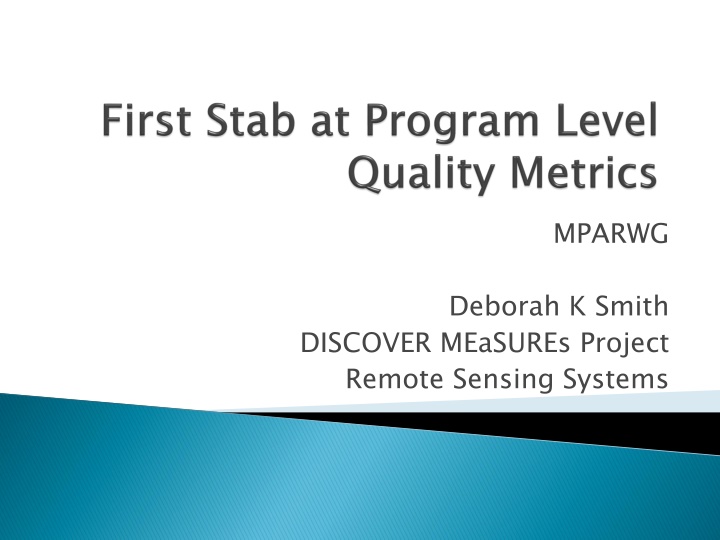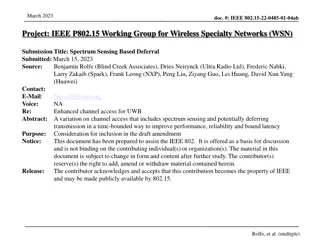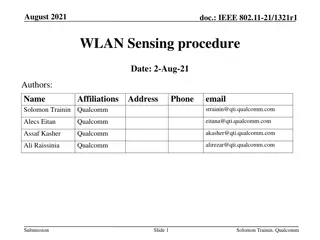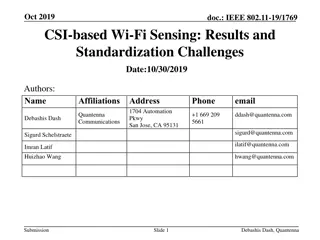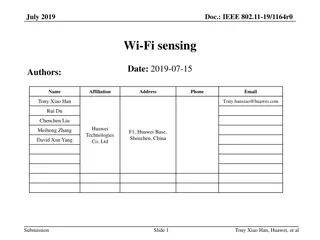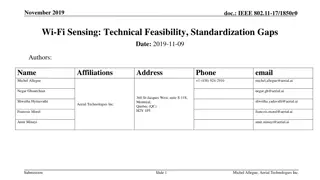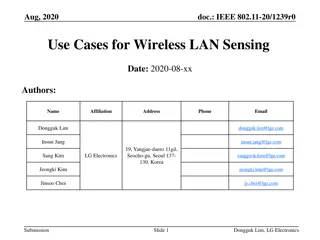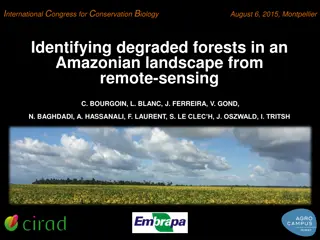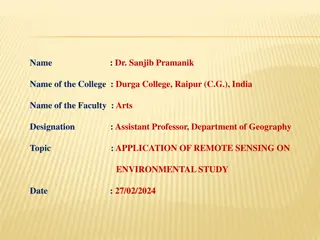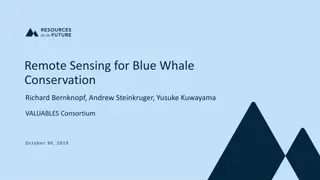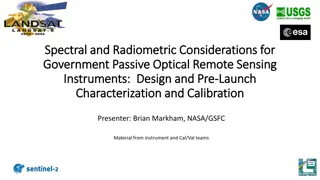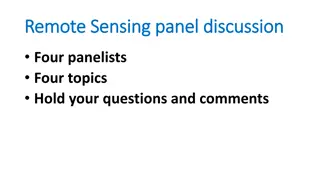MEASUREs Project: Remote Sensing Systems
Deborah K. Smith presents the MEASUREs Project, focusing on developing remote sensing systems for environmental monitoring and analysis. The project aims to enhance data collection and analysis capabilities through cutting-edge technology, with a particular emphasis on advancements in the field of remote sensing. Smith explores innovative approaches to utilizing remote sensing data for a range of applications, including resource management, disaster response, and climate research. The work promises to contribute significantly to the advancement of remote sensing technology and its practical applications across various domains.
Download Presentation

Please find below an Image/Link to download the presentation.
The content on the website is provided AS IS for your information and personal use only. It may not be sold, licensed, or shared on other websites without obtaining consent from the author.If you encounter any issues during the download, it is possible that the publisher has removed the file from their server.
You are allowed to download the files provided on this website for personal or commercial use, subject to the condition that they are used lawfully. All files are the property of their respective owners.
The content on the website is provided AS IS for your information and personal use only. It may not be sold, licensed, or shared on other websites without obtaining consent from the author.
E N D
Presentation Transcript
MPARWG Deborah K Smith DISCOVER MEaSUREs Project Remote Sensing Systems
Dr Frouins Criteria Table Strawman tables in Greg Hunolt s background notes Telecon in August with suggestion of answering a series of questions as a means to determine quality. Do the answers to questions lead to a metric of overall quality? Peter s presentation this morning on quality feedback from survey and his opinions. ESDSWG Mtg, New Orleans Oct 20-22 2010
A "straw-man proposal", a brainstormed simple proposal intended to generate discussion of its disadvantages and to provoke the generation of new and better proposals. Often, a straw man document will be prepared by one or two people prior to kicking off a larger project. In this way, the team can jump start their discussions with a document that is likely to contain many, but not all the key aspects to be discussed. -Wikipedia ESDSWG Mtg, New Orleans Oct 20-22 2010
A project with heritage. Weve been producing microwave ocean data products and making them available since 1996 under NASA Pathfinder funding. We have produced, and continue to produce and distribute many ocean products. Each product is assessed for quality before release to the public. We are currently releasing F16 and F17 SSMIS ocean products. I will use these as an example in this talk. ESDSWG Mtg, New Orleans Oct 20-22 2010
Is the data set complete? Are any gaps confirmed and documented? Are the data acceptably intercalibrated to previous data? Do the data products look as expected? (has a human eye checked the data set?) Are overall statistics within expected range? Are statistics for sub-regions or sub-time frames consistent with expectations and previous data? 1. 2. 3. 4. 5. 6.
Are comparison statistics with truth or other data (such as buoy, ship or model winds) within expected range? Is the data format consistent with previous data and what users expect? Are files read correctly by read routines, and if not, have changes been made? Have we completed or updated product documentation? 7. 8. 9. 10.
Have we informed the users of file format, processing steps, algorithm changes/specifics? Is a data validation file produced? Has all web and ftp text been updated? Have images been made and do the web tools to display them work correctly? Have we described to users the differences to expect? Is the data product like any other available, and if so, how does it compare? 11. 12. 13. 14. 15. 16.
Who have we created this data set for and will it meet those user needs? Do our tools work on the new data products? Are any new tools needed? What advances have occurred since we last asked these questions and should we change? 17. 18. 19. 20.
Have we checked the data within the extended time series? Are there any spurious trends in the data?
But what do the answers to these questions mean? What does the program want to know? Is an external body needed to determine the quality? If so, who? (program? DAAC? Other scientists? General public?) ESDSWG Mtg, New Orleans Oct 20-22 2010
Science Quality Level Science Quality Level To what degree have the data been validated? Comparison by both project and other scientists find similar results To what degree have the data been validated? To what degree do within already existing products? Time series analysis demonstrate the quality of intercalibration To what degree do the data fit within already existing products? To what degree is the data set complete and consistently processed? Data set complete, with documentation of known gaps, and consistently processed, extends previous values Data set complete and consistently processed To what degree is the data set complete and consistently processed? To is the data set used in the community? To what degree is the data set used in the community? what degree To what degree are the data accurate and precise? To what degree are the data accurate precise? the data fit and 4 Some are redistributing the data / Power users Measurements are both accurate and precise and derived values show expected and accepted ranges Accuracy and precision have been demonstrated by many Preliminary point comparisons show data are accurate and precise No assessment has been made 3 Comparison s to known references Extensive intercalibration performed Many routine users 2 Comparison s to other data products Preliminary intercalibration performed Data set consistently processed but has gaps Many users 1 No comparisons made by the project No intercalibration, but biases are known Data set has gaps and is not consistently processed Few users ESDSWG Mtg, New Orleans Oct 20-22 2010
Document Quality Document Quality Level To what degree is the data format described and usable? To what degree is the data format described and usable? To what degree are the algorithm and processing steps described? To what degree are the algorithm and processing steps described? To what degree can a new user begin using the data? To what degree can a new user begin using the data? Level 4 Data format is a commonly used standard accessible by 3rd party software Data format is described and read routines provided to users Data format is described Peer-reviewed publication describes algorithm and data production ATBD provided by data producer Can be using the data within 15 minutes and can confirm the data are accurate Can use the data accurately within a reasonable amount of time Time required to understand how to use the data Many hours and support emails needed to make sense of the data 3 2 Informal description provided with data 1 No data format information is provided No description provided ESDSWG Mtg, New Orleans Oct 20-22 2010
Accessibility/ Support Services Quality Accessibility/ Support Services Quality How users to read the data ? How easy is it for users to read the data ? easy is it for How easy is it for users data? How easy is it for users to obtain the data? To what degree can the user get help? To what degree can the user get help? to obtain the 4 Widely used standard file format User can access data with clients such as OpenDAP User can view and obtain the data using common tools Full support services available 3 Limited use file format, some common tools can be used Simple binary format with read routines Format described but no read routines available User can email the data producer 2 User can view the data on the web Online FAQ 1 User must download and write own program to access data No help ESDSWG Mtg, New Orleans Oct 20-22 2010
Overall Overall Quality Level Quality Level To what are users satisfied with data product? To what degree are users satisfied with data product? degree What is score from sub tables? What is score from sub- - tables? To what degree is the community using the data** Significant use To what degree is the targeted community using the data** To what degree is the broader community using the data? To what degree is the broader community using the data? targeted 4 Few questions to support services 10-12 Routinely used by journalists, students, applications Used by journalists 3 Some questions about data Questions about data and format Many questions 7-10 Routine use 2 4-7 Some use Some use by universities and researchers etc No use is evident 1 0-3 No use ** this can be obtained from user metrics already being collected and from citation metrics ESDSWG Mtg, New Orleans Oct 20-22 2010
Agreed-upon definitions of all terms Understanding of how questions carry meaning across projects (if any) An understanding of what Martha wants An understanding of the value of this information and how to communicate it Agreement on what the questions will be ESDSWG Mtg, New Orleans Oct 20-22 2010
